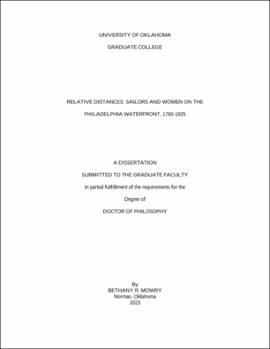| dc.description.abstract | This dissertation uses Philadelphia as a case study to reveal the varied and significant relationships—business, sexual and romantic, and familial—that connected Anglo-Atlantic sailors and women across land and sea between 1760 and 1825. Placing traditional social history sources such as city directories, maps, insolvency petitions, Alms House records, public-private aid society minutes, newspapers, and personal correspondence alongside analyses of maritime culture texts such as sailor songs, broadsides, periodicals, novels, plays, and prints, it reveals the motivations, close connections, and patterns of behavior that facilitated Philadelphia’s seafaring labor cycles. This research adds nuance to enduring portrayals of common seamen as footloose “Jack Tars” whose work separated them from land-based community and domestic life by choice or by fiat, and instead focuses on the everyday choices that sailors and women made to transcend physical distance and deliberately incorporate maritime labor cycles into their domestic, communal, and commercial lives. Connecting Atlantic history with histories of urban port cities, commerce, women and gender, and the family, this project also traces various changes over time, from the transformation of both sailors and working-class women into objects of moral intervention or nostalgic caricature to the transition between wooden and steam ships, the increased appearance of women as passengers and proxy crew on commercial and naval vessels, and shrinking legal and economic opportunities for women to act as femes soles in the absence of a male head of household. At the same time, it highlights key continuities, including the ubiquitous presence of women in and on the Philadelphia waterfront, interconnected oral performances and written transmissions of songs by and about sailors, and sustained patterns of cross-gender contact and connection in a diverse, dynamic, and expansive cityscape. | en_US |

